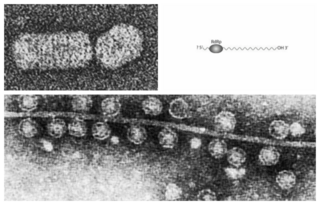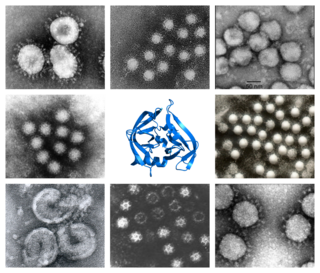Order is one of the eight major hierarchical taxonomic ranks in Linnaean taxonomy. It is classified between family and class. In biological classification, the order is a taxonomic rank used in the classification of organisms and recognized by the nomenclature codes. An immediately higher rank, superorder, is sometimes added directly above order, with suborder directly beneath order. An order can also be defined as a group of related families.
Virus classification is the process of naming viruses and placing them into a taxonomic system similar to the classification systems used for cellular organisms.

The International Committee on Taxonomy of Viruses (ICTV) authorizes and organizes the taxonomic classification of and the nomenclatures for viruses. The ICTV has developed a universal taxonomic scheme for viruses, and thus has the means to appropriately describe, name, and classify every virus that affects living organisms. The members of the International Committee on Taxonomy of Viruses are considered expert virologists. The ICTV was formed from and is governed by the Virology Division of the International Union of Microbiological Societies. Detailed work, such as delimiting the boundaries of species within a family, typically is performed by study groups of experts in the families.
Yuyuevirus is a genus of negative-strand RNA viruses which infect invertebrates. Member viruses have bisegmented genomes. It is the only genus in the family Yueviridae, which in turn is the only family in the order Goujianvirales and class Yunchangviricetes. Two species are recognized: Beihai yuyuevirus and Shahe yuyuevirus.

Articulavirales is an order of segmented negative-strand RNA viruses which infect invertebrates and vertebrates. It includes the family of influenza viruses which infect humans. It is the only order of viruses in the monotypic class Insthoviricetes. The order contains two families and eight genera.
Yingvirus is a genus of negative-strand RNA viruses which infect invertebrates. Member viruses have bisegmented genomes. It is the only genus in the family Qinviridae, which is the only family in Muvirales, which is the only order in Chunqiuviricetes. There are eight species in the genus.

Redondoviruses are a family of human-associated DNA viruses. Their name derives from the inferred circular structure of the viral genome . Redondoviruses have been identified in DNA sequence based surveys of samples from humans, primarily samples from the oral cavity and upper airway.
Papovaviricetes is a class of viruses. The class shares the name of an abolished family, Papovaviridae, which was split in 1999 into the two families Papillomaviridae and Polyomaviridae. The class was established in 2019 and takes its name from the former family.
Revtraviricetes is a class of viruses that contains all viruses that encode a reverse transcriptase. The group includes all ssRNA-RT viruses and dsDNA-RT viruses. It is the sole class in the phylum Artverviricota, which is the sole phylum in the kingdom Pararnavirae. The name of the group is a portmanteau of "reverse transcriptase" and -viricetes which is the suffix for a virus class.
Duplornaviricota is a phylum of RNA viruses, which contains all double-stranded RNA viruses, except for those in phylum Pisuviricota. Characteristic of the group is a viral capsid composed of 60 homo- or heterodimers of capsid protein on a pseudo-T=2 lattice. Duplornaviruses infect both prokaryotes and eukaryotes. The name of the group derives from Italian duplo which means double, rna for the type of virus, and -viricota which is the suffix for a virus phylum.

Ghabrivirales is an order of double-stranded RNA viruses. It is the only order in the class Chrysmotiviricetes. The name of the class is a portmanteau of member families: chrysoviridae, megabirnaviridae, and totiviridae; and -viricetes which is the suffix for a virus class. The name of the order derives from Said Ghabrial, a pioneering researcher who studied viruses in this order, and -virales which is the suffix for a virus order.
Kitrinoviricota is a phylum of RNA viruses that includes all positive-strand RNA viruses that infect eukaryotes and are not members of the phylum Pisuviricota or Lenarviricota. The name of the group derives from Greek κίτρινος (kítrinos), which means yellow, and -viricota, which is the suffix for a virus phylum.
Nodamuvirales is an order of positive-strand RNA viruses which infect eukaryotes. The name of the group is a contraction of "Nodamura virus" and -virales which is the suffix for a virus order.

Lenarviricota is a phylum of RNA viruses that includes all positive-strand RNA viruses that infect prokaryotes. Some members also infect eukaryotes. Most of these viruses do not have capsids, except for the genus Ourmiavirus. The name of the group is a syllabic abbreviation of the names of founding member families "Leviviridae and Narnaviridae" with the suffix -viricota, denoting a virus phylum.

Pisuviricota is a phylum of RNA viruses that includes all positive-strand and double-stranded RNA viruses that infect eukaryotes and are not members of the phylum Kitrinoviricota,Lenarviricota or Duplornaviricota. The name of the group is a syllabic abbreviation of “picornavirus supergroup” with the suffix -viricota, indicating a virus phylum. Phylogenetic analyses suggest that Birnaviridae and Permutotetraviridae, both currently unassigned to a phylum in Orthornavirae, also belong to this phylum and that both are sister groups. Another proposed family of the phylum is unassigned Polymycoviridae in Riboviria.
Durnavirales is an order of double-stranded RNA viruses which infect eukaryotes. The name of the group derives from Italian duplo which means double, rna for the type of virus, and -virales which is the suffix for a virus order.

Pisoniviricetes is a class of positive-strand RNA viruses which infect eukaryotes. A characteristic of the group is a conserved 3C-like protease from the PA clan of proteases for processing the translated polyprotein. The name of the group is a portmanteau of member orders "picornavirales, sobelivirales, nidovirales" and -viricetes which is the suffix for a virus class.

Sobelivirales is an order of RNA viruses which infect eukaryotes. Member viruses have a positive-sense single-stranded RNA genome. The name of the group is a portmanteau of member orders "sobemovirus-like" and -virales which is the suffix for a virus order.

Stelpaviricetes is a class of non-enveloped, positive-strand RNA viruses which infect plants and animals. Characteristic of the group is a VPg protein attached to the 5'-end of the genome and a conserved 3C-like protease from the PA clan of proteases for processing the translated polyprotein. The name of the group is a syllabic abbreviation of member orders "stellavirales, patatavirales" with the suffix -viricetes denoting a virus class.

Adnaviria is a realm of viruses that includes archaeal viruses that have a filamentous virion and a linear, double-stranded DNA genome. The genome exists in A-form (A-DNA) and encodes a dimeric major capsid protein (MCP) that contains the SIRV2 fold, a type of alpha-helix bundle containing four helices. The virion consists of the genome encased in capsid proteins to form a helical nucleoprotein complex. For some viruses, this helix is surrounded by a lipid membrane called an envelope. Some contain an additional protein layer between the nucleoprotein helix and the envelope. Complete virions are long and thin and may be flexible or a stiff like a rod.









